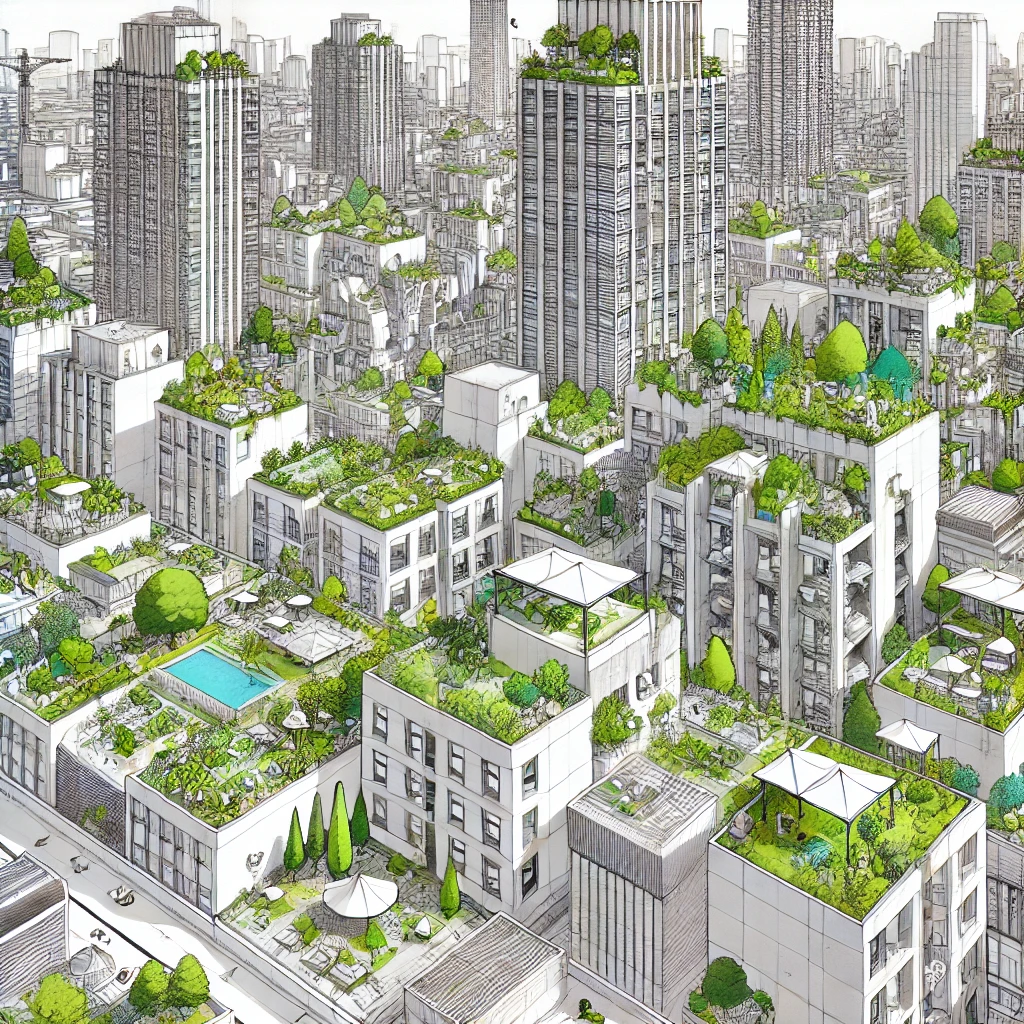Why Every Building Should Have a Green Roof: Towards a More Resilient Architecture
In our pursuit of resilient and human-centered architecture, it is imperative to reconsider how we use one of the most underutilized spaces in our built environment: the roof. Conventional roofing systems do little beyond shielding a structure from the elements, effectively rendering them dead zones in a landscape that increasingly lacks natural permeability and biodiversity. If we are to create truly sustainable architecture, we must rethink our approach and look towards green roofs as a standard practice rather than an exception.
The Rationale for Green Roofs
European cities have long utilized rooftops effectively, historically through terraces and communal spaces rather than green roofs. However, in recent decades, cities like Basel, Hamburg, and Paris have actively implemented policies to promote green roofs as part of urban sustainability efforts. Basel, for example, has mandated green roofs on new and renovated flat-roofed buildings since the 1990s, while France passed a nationwide law in 2015 requiring commercial buildings to incorporate either vegetation or solar panels. Hamburg has committed to greening at least 70% of new buildings and suitable renovated roofs.
Germany leads Europe in green roof adoption, with approximately 3.1 million square kilometers of green roofs, making up around 8% of its total roofed area. Meanwhile, North America has also seen increasing adoption, with cities like Chicago adding over 56,000 square meters of green roofs in 2023 alone.
These trends highlight that successful green roof implementation relies on strong policy backing and public awareness. Auckland, like many cities facing increasing density and climate challenges, should take inspiration from these leading examples and integrate rooftop gardens and green infrastructure into urban planning. By reinstating displaced natural landscapes onto buildings, we can enhance biodiversity, mitigate urban heat, and create functional outdoor spaces that benefit both people and the environment.
The Benefits of Green Roofs
Environmental Benefits
Stormwater Management – Green roofs absorb and filter rainwater, reducing runoff that can overwhelm urban drainage systems and contribute to flooding.
Urban Heat Island Mitigation – Traditional roofing materials absorb heat and contribute to increased temperatures in urban areas. Green roofs counteract this by providing insulation and cooling through evapotranspiration.
Air Quality Improvement – Plants absorb pollutants and carbon dioxide while releasing oxygen, leading to cleaner and fresher air in densely populated areas.
Biodiversity Support – By reinstating native flora, green roofs provide crucial habitats for birds, bees, and other pollinators that would otherwise be displaced by urban sprawl.
Social & Psychological Benefits
Enhancing Well-being – Access to green spaces has been proven to reduce stress, improve mental health, and increase overall well-being.
Maximizing Outdoor Space – Green roofs create functional terraces for recreation, relaxation, and even urban agriculture, providing much-needed outdoor spaces as land becomes scarce.
Acoustic Insulation – Vegetation helps to absorb sound, reducing noise pollution from traffic, airplanes, and other urban disturbances.
Privacy Considerations – Thoughtful design ensures that rooftop spaces balance communal access with privacy needs, creating secluded green havens within the urban fabric.
Economic Benefits
Energy Efficiency – Green roofs provide natural insulation, reducing heating and cooling costs by improving thermal performance.
Extended Roof Lifespan – The additional layers protect roofing membranes from UV radiation and temperature fluctuations, extending their durability.
Perceived Property Value – While some buyers may appreciate the benefits of green roofs, others may hesitate due to concerns about maintenance. Educating homeowners on long-term savings and durability is key to addressing these perceptions.
Challenges and Considerations
While the benefits of green roofs are substantial, they must be balanced against practical considerations such as cost, structural requirements, and maintenance.
Structural Load & Installation
A green roof adds significant weight to a building, requiring proper structural engineering to ensure the roof can support soil, vegetation, and water retention.
Retrofitting an existing building may require reinforcement, which can be costly and logistically challenging.
Cost Factors
Initial Costs – The upfront investment for a green roof is typically higher than traditional roofing due to waterproofing layers, drainage systems, and soil preparation.
Long-term Savings – These costs are offset over time through reduced energy bills, lower maintenance requirements for roofing membranes, and increased property value.
Government Incentives – Some cities offer subsidies or incentives for green roofs, a policy that Auckland could implement to encourage wider adoption.
Maintenance & Public Perception
Extensive green roofs (lightweight, low-maintenance) require minimal upkeep, typically just seasonal weeding and watering.
Intensive green roofs (designed for gardens or urban farming) require regular care, similar to a traditional garden, but offer more functionality.
Many homeowners and developers may be hesitant to adopt green roofs due to perceived high maintenance needs. However, with proper design and plant selection, maintenance can be significantly reduced. Addressing these concerns through education and demonstration projects could help shift perceptions.
Towards a Smarter Use of Space
Given the mounting pressures of urbanization and climate change, our approach to architectural design must evolve to embrace holistic solutions. Green roofs present an opportunity to transform lifeless rooftops into thriving landscapes that work in harmony with the environment. They are not just an aesthetic feature but a necessity for a resilient and regenerative built environment.
For Auckland, where density is increasing and green space is at risk of being lost, integrating rooftop gardens, urban farms, and landscaped terraces should be a priority. Local governments, developers, and architects must recognize that sustainable design is no longer an optional luxury but a critical component of future-proofing our cities. With smart design choices that consider privacy, acoustics, and functionality, we can create rooftop environments that enhance quality of life while mitigating the environmental impact of urban expansion.
The question should no longer be why we use green roofs but rather why not? If we are taking land from nature, the least we can do is give a portion of it back—elevating the lost landscape to new heights and ensuring that our cities are not just livable, but beautiful, resilient, and biophilic thriving ecosystems.
